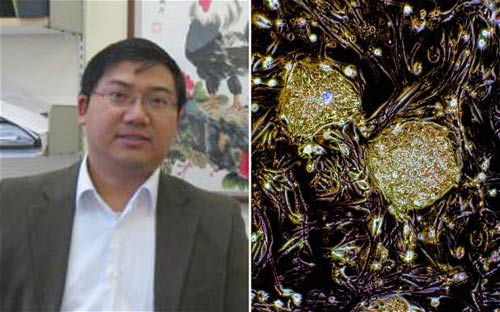|
 Scientist Dr Will Shu, from Heriot-Watt University in Edinburgh has lead the research into the 3D printing technique that produces clusters of stem cells |
|
A 3D printing technique that produces clusters of stem cells could speed up progress towards the creation of artificial organs, scientists claim. In the more immediate future it could be used to generate biopsy-like tissue samples for drug testing. The technique relies on an adjustable "microvalve" to build up layers of human embryonic stem cells (hESCs). Altering the nozzle diameter precisely controls the rate at which cells are dispensed. Lead scientist Dr Will Shu, from Heriot-Watt University in Edinburgh, said: "We found that the valve-based printing is gentle enough to maintain high stem cellviability, accurate enough to produce spheroids of uniform size, and most importantly, the printed hESCs maintained their pluripotency - the ability to differentiate into any other cell type." Embryonic stem cells, which originate from early stage embryos, are blank slates with the potential to become any type of tissue in the body. The research is reported today in the journal Biofabrication. In the long term, the new printing technique could pave the way for hESCs being incorporated into transplant-ready laboratory-made organs and tissues, said the researchers. The 3D structures will also enable scientists to create more accurate human tissue models for drug testing. Cloning technology can produce embryonic stem cells, or cells with ESC properties, containing a patient's own genetic programming. Artificial tissue and organs made from such cells could be implanted into the patient from which they are derived without triggering a dangerous immune response. Jason King, business development manager of stem cell biotech company Roslin Cellab, which took part in the research, said: "Normally laboratory grown cells grow in 2D but some cell types have been printed in 3D. However, up to now, human stem cell cultures have been too sensitive to manipulate in this way. "This is a scientific development which we hope and believe will have immensely valuable long-term implications for reliable, animal-free, drug testing, and, in the longer term, to provide organs for transplant on demand, without the need for donation and without the problems of immune suppression and potential organ rejection." (Read by Brian Salter. Brian Salter is a journalist at the China Daily Website.) (Source: Telegraph) |
科学家称,现在可以用3D打印技术批量制造出干细胞,这一技术将能加速实现打印人造器官的进程。 在不久的未来,这种3D打印技术可以用来制造类活组织物质,作为药物测试的样品。 该技术依靠可调节的“微型阀”来制造出一层层的人体胚胎干细胞。 通过改变喷嘴直径可精确地控制干细胞产出的速度。 首席科学家、来自爱丁堡赫瑞瓦特大学的威尔•休博士说:“我们发现,这一依靠阀来调节的打印技术很温和,能保持干细胞的高存活率,也能准确地制造出大小一致的球状体,最重要的是,打印出的人体胚胎干细胞能保持它们的多能型,即分化成其他类型细胞的潜能。” 源自早期胚胎的胚胎干细胞就像一块白板,有潜能成为身体内任何一种组织。 这一研究报告今日发表在《生物制造》杂志上。 研究人员表示,从长远来看,这一新打印技术将为人体胚胎干细胞用于实验室制造的可移植人体器官和组织铺平道路。 3D打印出的人造器官还能让科学家制造出更准确的人体组织模型,用于药物测试。 克隆技术可以制造出包含病人自身遗传基因的胚胎干细胞,或具备胚胎干细胞性能的细胞。 用这种细胞制造出来的人造组织和器官可以被移植到原细胞所有者体内,而不会引发危险的免疫反应。 参与这一研究的干细胞生物科技公司Roslin Cellab的业务发展经理杰森•金说:“通常实验室制造的细胞是用2D方式培育出来的,但现在已经3D打印出一些类型的细胞。不过,迄今为止,人体干细胞文化一直都比较敏感,还不能这么操作。 “我们希望也相信这一科学发展对不用动物的可靠药物测试会有极大的价值和长远意义,在更长远的未来,还能应移植需求提供器官,不再需要器官捐献,也不会产生免疫抑制和潜在的器官排斥问题。” 相关阅读 (中国日报网英语点津 陈丹妮 编辑:Julie) |
|
Vocabulary: biopsy: 活组织标本 viability: 生存能力 spheroid: 球状体;回转椭球体 pluripotency: 多能性 differentiate: (细胞或组织)分化 |
